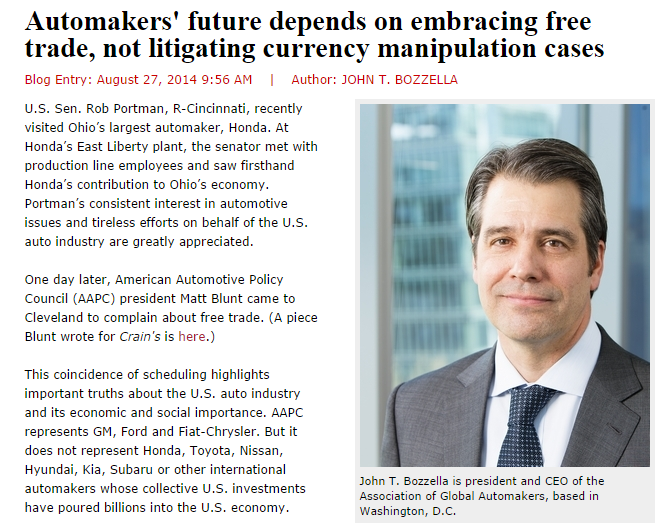August 27, 2014 Author: JOHN T. BOZZELLA
U.S. Sen. Rob Portman, R-Cincinnati, recently visited Ohio’s largest automaker, Honda. At Honda’s East Liberty plant, the senator met with production line employees and saw firsthand Honda’s contribution to Ohio’s economy. Portman’s consistent interest in automotive issues and tireless efforts on behalf of the U.S. auto industry are greatly appreciated.One day later, American Automotive Policy Council (AAPC) president Matt Blunt came to Cleveland to complain about free trade. (A piece Blunt wrote for Crain’s is here.)
This coincidence of scheduling highlights important truths about the U.S. auto industry and its economic and social importance. AAPC represents GM, Ford and Fiat-Chrysler. But it does not represent Honda, Toyota, Nissan, Hyundai, Kia, Subaru or other international automakers whose collective U.S. investments have poured billions into the U.S. economy.
This is important because it means that when the AAPC takes an anti-trade position — like it did with representatives of the steel and textile industries — it does not and cannot speak on behalf of the entire U.S. auto industry.
Nor can the AAPC speak for the Ohio auto industry. That’s because Honda makes more vehicles in Ohio each year than GM, Ford and Fiat-Chrysler combined. Honda also directly employs 14,300 workers at its Ohio-based facilities and builds in the U.S. seven out of 10 cars and trucks it sells in the United States. Honda even exports more vehicles built in the United States by Americans to other countries than it imports from Japan.
Today there are 13 automakers producing motor vehicles in the United States. The majority of these companies originated abroad but have made America — and places like Ohio — their home.
Collectively, these international automakers now account for 45% of U.S. auto manufacturing and 59% of U.S. auto sales. Investments by international automakers also have created jobs for 100,000 Americans, generate an annual payroll of more than $9 billion, and created an additional 500,000 jobs through nearly 10,000 dealership franchises nationwide. They and their dealers are reshaping the American auto industry.
Here’s the bottom line: There are significant differences of opinion on trade among U.S. automakers. Global automakers and companies like Honda believe that success in any market requires a long-term commitment, an investment strategy that doesn’t waver with the economic cycle, and engagement with consumers that delivers what they want.
The AAPC offers a different perspective.
The benefits of an innovative and open automobile industry are clear. From East Liberty, to Toledo, to Avon Lake, the Buckeye State is a microcosm of what the U.S. industry truly is today. Original Source: Crain’s Click to view PDF:


